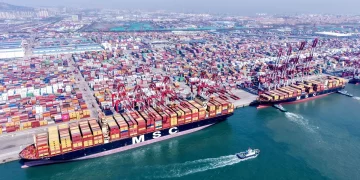Introduction
The global economic landscape is undergoing a significant transformation as countries around the world reassess their economic alliances and shift toward new forms of multilateral cooperation. The old paradigms of economic power, dominated by traditional alliances like the U.S.-EU or China’s influence over the Asia-Pacific region, are evolving. Emerging economic powers, new geopolitical challenges, and the acceleration of digital transformation are all playing pivotal roles in reshaping how nations engage with one another economically. As the world enters this new era of economic alliances, the implications for international trade, investment, and global governance are profound.
This article explores the key drivers behind the changing global economic alliances, the rise of non-traditional economic partnerships, and the impact these shifts will have on investment strategies and economic policy.
1. Reevaluating Traditional Economic Alliances and Multilateral Cooperation
Historically, the world has been dominated by a few powerful economic blocs: the U.S. and its allies, the European Union, and China as the central economic engine of the Asia-Pacific. For decades, these regions have been the linchpins of global trade and economic governance. However, growing political and economic challenges are leading many countries to reevaluate their reliance on traditional alliances and multilateral institutions.
The United States, for example, has been more cautious about its international trade commitments, as evidenced by the U.S.-China trade war and the America First policy under the Trump administration. While the Biden administration has taken steps to restore alliances, it has also emphasized the need for the U.S. to be more self-reliant in certain areas, such as supply chain resilience and energy independence. This shift has led to a more transactional approach in foreign relations, with countries increasingly asking: What’s in it for us?
Similarly, the European Union, while still a dominant player in global trade, is facing internal and external challenges that are testing its cohesion. Brexit has highlighted the complexities of economic and political alliances within the EU, while rising populist movements in several European countries are challenging the EU’s traditional unity. As a result, European leaders are more willing to explore new partnerships beyond the EU’s traditional sphere of influence, focusing on building regional and bilateral agreements with countries in Asia, Africa, and Latin America.
2. The Rise of Non-Traditional Economic Partnerships
In recent years, the emergence of non-traditional economic partnerships has been one of the most notable shifts in the global economic order. These new alliances often do not follow the conventional paths of political and economic relationships and reflect a more pragmatic approach to international cooperation.
One of the most significant examples of this shift is the growing ties between China and countries in Africa, Latin America, and the Middle East. China’s Belt and Road Initiative (BRI), which seeks to build infrastructure and promote trade across a vast network of countries, has enabled China to form strategic economic partnerships with emerging economies. These partnerships often bypass traditional Western institutions, focusing instead on practical investments, such as infrastructure projects, energy, and technology.
The rise of the “Global South,” particularly the BRICS (Brazil, Russia, India, China, and South Africa) group, has further exemplified this trend. The BRICS nations are increasingly playing a more assertive role in global economic governance, pushing for reforms in institutions like the International Monetary Fund (IMF) and the World Bank to reflect the growing influence of developing economies. These countries are also seeking to diversify their economic ties away from Western powers, forging new trade agreements with each other and with countries across Africa and Asia.
In addition to these new South-South alliances, countries like India, Vietnam, and even smaller nations in Central Asia are finding common ground in their shared economic goals. For example, India’s “Act East” policy has sought to strengthen trade relations with Southeast Asia, Australia, and Japan, positioning India as a critical player in the Indo-Pacific region. Similarly, countries in Latin America are increasingly turning to China as a key economic partner, with Chinese investment flooding into the region, particularly in sectors like agriculture, mining, and infrastructure.

3. The Implications for Investment and Economic Policy
As these new economic alliances reshape global trade flows, investors will need to adjust their strategies to navigate the evolving geopolitical landscape. The shifting dynamics present both risks and opportunities, and understanding the drivers behind these changes will be essential for making informed investment decisions.
Investment Opportunities in Emerging Markets
One of the most significant opportunities arising from this shift is the growing importance of emerging markets. With traditional Western economic powers focusing more on internal issues, many emerging economies are stepping up as key drivers of global growth. Countries in Asia, Africa, and Latin America are benefiting from the influx of foreign investment, particularly in infrastructure, technology, and manufacturing. Investors looking to capitalize on these trends may find significant opportunities in sectors such as renewable energy, consumer goods, and digital infrastructure in these regions.
For example, China’s economic relationships with Africa have led to substantial investments in infrastructure, particularly in transportation, energy, and telecommunications. Investors with a long-term perspective may find growth opportunities in these industries as the continent continues to urbanize and modernize. Additionally, the increased focus on regional supply chains and de-globalization trends may lead to new opportunities in markets that were previously overlooked, such as Vietnam and Indonesia.
Economic Policy Adjustments: Trade Deals and Currency Shifts
Countries are increasingly focusing on trade agreements that are more tailored to their specific needs and less dependent on large, multilateral organizations. For example, the Regional Comprehensive Economic Partnership (RCEP), a trade agreement between 15 countries in the Asia-Pacific region, was signed in 2020, creating one of the world’s largest free trade areas. The agreement includes China, Japan, and South Korea, among others, and aims to reduce tariffs and increase trade flows between the member countries. Similarly, the African Continental Free Trade Area (AfCFTA) is designed to enhance intra-African trade, reduce trade barriers, and create a single market for goods and services across the continent.
As the global economic order shifts, there are also implications for currency markets and monetary policy. For example, countries in the BRICS group have increasingly sought to reduce their reliance on the U.S. dollar in international trade, turning to alternative currencies like the Chinese yuan or regional currencies in bilateral trade agreements. This shift has the potential to alter the global financial system, with greater emphasis placed on regional currencies and trade mechanisms that bypass the dollar-dominated financial infrastructure.
4. The Future of Global Economic Alliances: What’s Next?
Looking ahead, it is clear that global economic alliances will continue to evolve in response to shifting geopolitical and economic realities. The world is becoming more multipolar, with emerging economies taking on greater roles in global governance and trade. The rise of non-traditional partnerships, such as China’s growing influence in Africa and Latin America, will likely continue to challenge the dominance of Western economic powers in key sectors.
For investors, this evolving landscape offers both challenges and opportunities. The growing importance of emerging markets, the rise of regional trade agreements, and the shifting role of currencies will all play critical roles in shaping the future of global trade. To succeed in this new era of economic alliances, investors will need to adopt a more flexible and nuanced approach, taking into account the geopolitical, economic, and technological trends that are reshaping the global marketplace.
Conclusion
The world is witnessing a dramatic shift in global economic alliances, with countries reevaluating their traditional partnerships and seeking new economic relationships based on mutual interests rather than long-standing political ties. As emerging markets gain prominence and non-traditional economic alliances continue to grow, investors must remain agile and responsive to the changing dynamics of global trade. The future of global economic alliances promises to be more complex and interconnected, with new opportunities emerging in unexpected places. For both policymakers and investors, understanding and adapting to these changes will be crucial for thriving in this new era of global economic cooperation.































